“Biological recording – fit for purpose?
Around 180 people assembled at the Royal Society in London on 23rd November for the 12th annual conference of the NBN. This was the largest attendance so far, beating the previous year’s record attendance by a considerable margin, perhaps reflecting the impetus which has built up, as the quantity of biodiversity data on the NBN Gateway has reached a ‘critical mass’ that attracts even more participants to want to take part.
Quantity, though, does not necessarily equate with quality, or with usefulness, and so the Conference this year was deliberately focused on the way we do recording, and what the outputs are. This came about partly because the NBN Trust itself has been asking these questions, but also partly because external bodies are increasingly needing more ‘useful’ data. The issues are: how can we improve things to try and meet these needs, and at the same time make sure that those involved in recording maintain their desire to take part? At the same time, recording methods are being changed by changing technology all the time, so that what was impossible three years ago is now feasible, and rapidly being adopted. These were the background ideas in people’s minds during the day.
The talks were chosen to give a picture of both the ‘demand’ for quality data; and also to highlight what we are doing to achieve this in different ways – through recruiting new people, making use of new technologies and developing new ways of making use of those data.
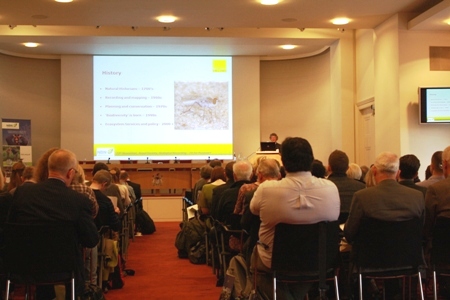
The morning talks were quite inspirational in many ways. Keith Porter’s opening talk about the need for us to maintain and develop from what we have achieved so far, so that ‘more data gives us better biodiversity’, was a clarion call to get on with the ‘modernisation’ we have been carrying out for the last ten years. He was the first to highlight ‘on-line recording’ as a key element in this; and this theme was a part of many other talks in different ways.
Download Keith Porter's presentation
Linda Davies reflected on the effects of the Big Lottery-funded OPAL (Open Air Laboratories) Project, which she has led for five years, and in which the NBN Trust has been a part. On-line recording was part of this, of course, with the development of ‘Indicia’ and its implementation recently in ‘iRecord’, through the Biological Records Centre. But another major strand of this Project was the idea of ‘citizen science’, and the way we engage with more people generally. She used the way that OPAL worked with the British Lichen Society as an example, although this also served as a warning – in that so much important data relies on so few expert people (just 6 people in the BLS have contributed 50% of the 1.2 million available records!).
Download Linda Davies' presentation
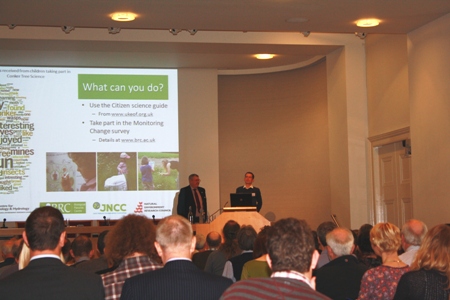
Michael Pocock of CEH Wallingford continued the ‘citizen science’ theme, with an enthusiastic and thoughtful contribution, exploring how effective these methods can be, with an example from the unlikely ‘Conker Tree Science’ Project, where 18,000 ordinary members of the public took part. He highlighted the development of ‘apps.’ for modern phones as an example of new technologies coming on stream fast. The opportunities for the NBN in making use of these in well-thought-through processes are substantial.
Download Michael Pocock's presentation
As a contrast to Michael’s talk, Nick Isaac, also of CEH, showed us that the data from this rather unfocused recording effort is not necessarily unusable, given sophisticated approaches to its analysis, with modern statistical methods. However, he did stress that we could make even better use of data if we are ‘smarter’ about their collection in the first place – very much Keith Porter’s message too.
Download Nick Isaac's presentation
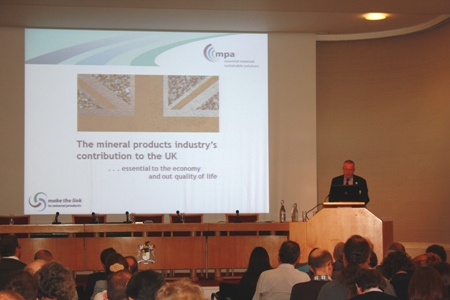
Finally in the morning, Nigel Jackson, Chief Executive of our sponsors for the day, the Minerals Products Association, gave us a thoughtful and insightful view of the way that this apparently (to some) destructive industry actually is able to make a significant contribution to biodiversity overall. As they represent a large number of quarrying organisations, they are in a good position to influence the way the industry might take part in the NBN in the future.
During the lunchtime session, delegates took the opportunity to discuss issues and to examine the various demonstrations: Indicia and its use in iRecord, the new NBN Gateway access controls, iSpot, the Botanical Society of the British Isles’ new on-line ‘Distribution Database’, the UK Earth Observation Framework, developing work of the Natural History Museum’s Angela Marmont Centre, and Defra’s current projects. 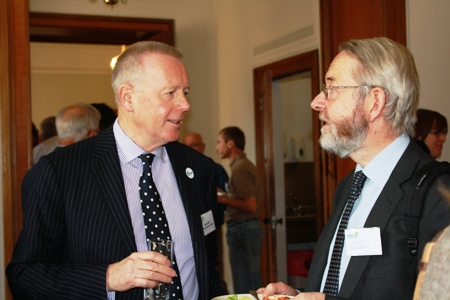
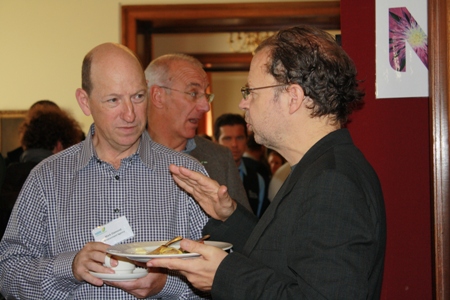
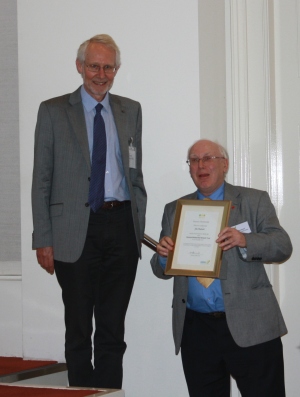
In the afternoon, we first saw John Newbould, current Secretary of the National Federation for Biological Recording, and long-time Secretary of the Yorkshire Naturalists’ Union, among many other ‘hats’, given NBN Trust’s Honorary Membership by its Chairman, Prof. Michael Hassell.
The session was then led by our keynote speaker, giving the Sir John Burnett Memorial Lecture – Prof. Sir John Lawton, former Government Chief Scientist, and author of the recent ‘Lawton report’ – Making space for nature, which advocated the adoption of what are now being called ‘Nature Improvement Areas’, following the adoption of key ideas by the Government. He gave us a very lively and enthusiastic presentation on the thinking behind this report, and highlighted the vital role of ongoing biological recording as the bedrock on which the concept is built.
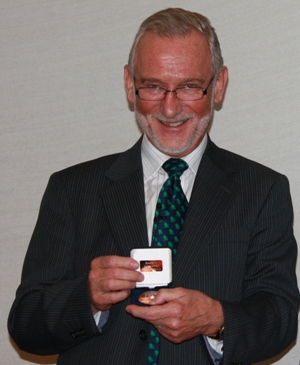
Download Sir John Lawton's presentation
The rest of the afternoon’s contributions were aimed to re-visit three kinds of biodiversity data to get a view as to how people saw these in the light of potential uses. The first was the data and the systems behind their capture and use in operation across the country’s diverse Local Environmental Records Centres, given to us by Tom Hunt, recently appointed Development Officer for the Association of Local Environmental Records Centres. He had compiled a detailed inventory of the current picture, and highlighted the ‘patchiness’ of LERC data, but also its strengths – particularly their use of habitat data.
Download Tom Hunt's presentation
Sarah Whild of the BSBI and (until recently) University of Birmingham’s Gateway Centre at Shrewsbury – now being taken over by the Manchester Metropolitan University – gave us an insight into how detailed plant data can be used to inform large-scale habitat management processes, using the concept of ‘axiophytes’ (‘special’ plants that indicate quality habitat). This emphasised that individual records, brought together and properly-interpreted, can be a powerful tool in driving our attempts at improving the environment using ecological understanding.
Download Sarah Whild's presentation
Download Ian Wallace's presentation
Finally, Ian Wallace, the Caddis Recording Scheme Organiser, stood in for Craig Macadam of the Mayfly Recording Scheme, suffering from a recently injured hand, who was to have told us about the current position with these ‘smaller’ recording schemes, by their development of joint working through the Riverfly Group. In the event, Ian’s talk was both amusing and inspiring, showing that, even with such ‘difficult’ groups, much can be achieved. The citizen-science theme came back, and Ian’s main messages were that continued motivation of the volunteers is the basic challenge, and that getting them to record ‘useful’ information is actually the way to make sure this happens. So, this came back to the message that Keith Porter started with – recording better, in a more streamlined way, is actually the best way forward for us all.
Trevor James
Conference Programme Organiser
Video recording
For the first time, the Conference was video recorded in order to capture the event for those who were unable to attend. The morning and afternoon sessions can be viewed by clicking on the YouTube links below:
Morning session
The timings of the sessions are as follows:
- Welcome and introduction by NBN Trust Chairman, Professor Michael Hassell 00:00 – 01:42
- Biological Recording: change and transition – Keith Porter, Natural England 01:50 – 27:35
- Anyone can send in records! – Linda Davies, Imperial College/OPAL Project 27:36 – 58:00
- Citizen science and its role in policy, research and engagement, Michael Pocock, NERC Centre for Ecology & Hydrology 58:08 – 01:48:01
- Interpreting biodiversity under diverse syndromes of recording behaviour, Nick Isaac, NERC Centre for Ecology & Hydrology 01:48:03 – 02:23:08
- The mineral products industry – uniquely placed to benefit nature Nigel Jackson, Chief Executive, Mineral Products Association 02:23:10 – 02:46:20
- Presentation of 75 millionth record certificate 02:46:21 – 02:47:36
{^youtubevideo|(width)425|(height)264|(autoplay)False|(hd)False|(color1)#666666|(url)http://youtu.be/oIiUsyAQfpE|(rel)False|(color2)#EFEFEF|(loop)False|(border)False|(cookies)False|(fs)True^}
Afternoon session
The timings of the afternoon sessions are as follows:
Honorary membership award – 00:00 – 01:55
Sir John Burnett Memorial lecture – 01:56 – 41:00
Tom Hunt “Complex mosaic or patchy mess? – the current picture of Local Record Centre data” – 41:01 – 01:12:20
Sarah Whild “Axiophytes — using plant indicators for landscape conservation” – 01:12:25 – 01:39:49
Ian Wallace – “Riverfly Recording – 10 year's of progress” – 01:39:50 – 02:16:21
Chairman's summing up – 02:16:28 – 02:19:00
{^youtubevideo|(width)425|(height)264|(hd)False|(url)http://youtu.be/e6HkbQMRi2c|(autoplay)False|(color1)#666666|(rel)False|(color2)#EFEFEF|(loop)False|(border)False|(cookies)False|(fs)True^}
